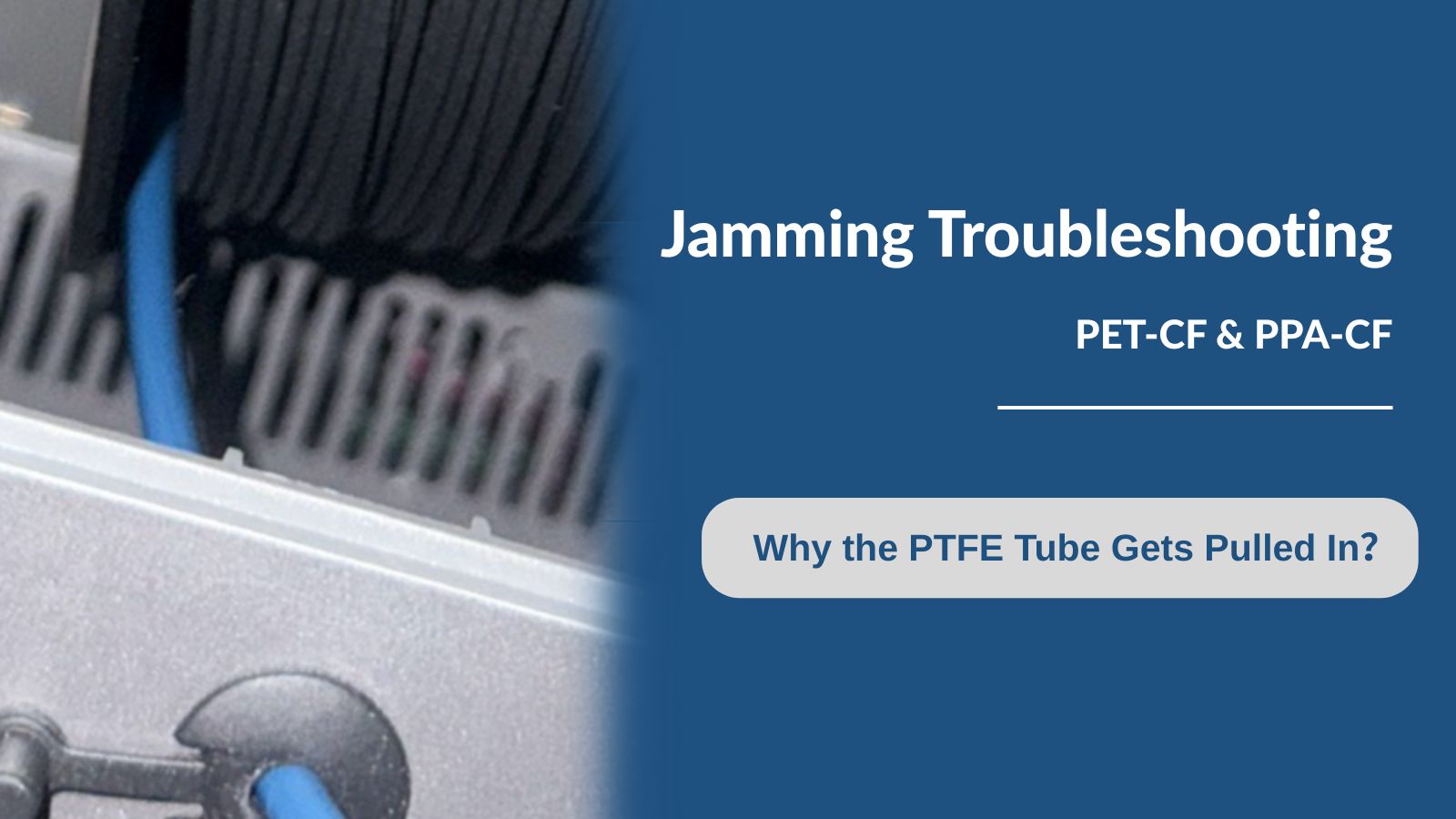PET-CF、PPA-CF、PPA-CF Coreといった高性能フィラメントは、強度と耐久性に優れた3Dプリントの実現に驚くべき可能性をもたらします。しかし、これらの先進的な素材を扱うには、特に水分管理に関して特別な取り扱いが必要です。そのため、プリント中はドライボックスの使用が不可欠です。
ベストプラクティスにもかかわらず、ユーザーから特に困った問題が発生しているとの報告を受けています。フィラメントの供給がうまくいかないだけでなく、PTFEガイドチューブ自体がドライボックスに引き込まれ、フィラメントスプールに引っかかってしまうのです。その結果、必然的にプリントが停止してしまいます。

PTFE チューブがドライボックスに引き込まれるのはなぜですか?
-
高い摩擦と剛性: PET-CFとPPA-CFは、PLAやPETGなどの材料よりもはるかに剛性が高いです。この剛性により、フィラメントがPTFEガイドチューブを通過する際に、本質的に非常に高い摩擦が発生します。
-
フィラメントの絡まり(主な原因):これらの硬いフィラメントは、切断時に勢いよく跳ね上がることがあります。フィラメントの先端をすぐに固定(例えば、フィラメントクリップで固定)しないと、取り扱い時や巻き戻し時に、スプール上の他のフィラメントの下に簡単に滑り込んでしまいます。これにより、フィラメントが絡まったり、交差したりして、後でフィラメントを送り出す際に必要な引っ張り力が大幅に増加します。(これは非常に重要なポイントです。たとえ1つのループが他のループの下に引っかかっただけでも、問題を引き起こすのに十分な力が発生することがあります。)
-
チューブ保持力不足:多くのドライボックスのPTFEチューブ接続部は、チューブを簡単に取り外せるように設計されており、シンプルなキャップやコレットが用いられることが多いです。しかし、この接続部では、硬い、絡まった、あるいは摩擦の大きいフィラメントによって発生する強い引っ張り力に耐えるだけの十分なグリップ力が得られず、チューブが内側に滑り込んでしまう場合があります。
-
段ボールスプールの問題:段ボールスプール自体がわずかに変形したり、抵抗が生じたり、ホルダー上でスムーズに回転しなかったりして、フィラメントのパスに抵抗が加わる場合があります。
-
吸湿性:チューブが引き込まれる直接的な原因ではありませんが、これらのフィラメントは乾燥した状態に保つ必要があります。湿ったフィラメントで印刷すると、膨張や脆化により摩擦が増加する可能性があり、他の問題を引き起こす可能性があります。
結果:摩擦がグリップを上回り、チューブが引き込まれる
ソリューションとベストプラクティス
1. もつれを防ぐ(一番の原因)
最初にフィラメントを開いて切断するときは、フィラメントが乱暴に飛び出さないように確実に制御してください。
2. PTFEチューブの接続を固定する:
-
- ドライ ボックスの出口にある既存の PTFE チューブ コネクタ/カプラーが正しく機能し、チューブを意図したとおりにしっかりと固定していることを確認します。
- フィッティングのアップグレードを検討する:標準のキャップまたはコレットをより安全な空気圧式フィッティング (気管コネクタまたはプッシュフィット コネクタと呼ばれることもあります) に交換すると、PTFE チューブのグリップが大幅に向上し、フィラメントの摩擦によってチューブが内側に引っ張られるのがはるかに難しくなります。
3. チューブ内部の長さを最小化する
ドライボックス内にPTFEチューブが突き出ている部分は、フィラメントをスプールからスムーズに引き出せる程度に短くしてください。チューブの内側部分が長すぎると、フィラメントがわずかに内側に引っ張られた際に、チューブの先端がスプールに引っかかる可能性が高くなります。内側部分を短くすることで、詰まりが発生するまでの「余裕」が生まれます。
4. スプールのスムーズな回転を確保する:
スプールが正しくセットされ、引っ掛かりや過度の抵抗がなく自由に回転することを確認してください。変形した段ボールが動きを妨げていないことを確認してください。
5. フィラメントの完全なパスを確認します。
ドライボックスの外側のPTFE チューブに、不要な摩擦を生じさせるような鋭い曲がりやねじれがないことを確認してください。
6. 適切な積載方法:
フィラメントをスプールからチューブにスムーズに送り込み、スプールの表面に最初の引っ掛かりや目に見える交差がないか注意します。

